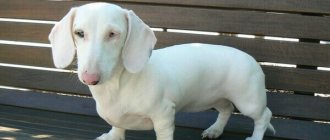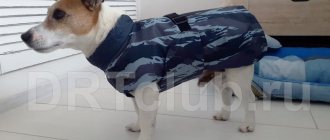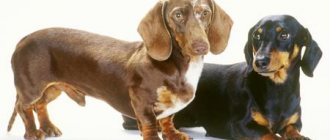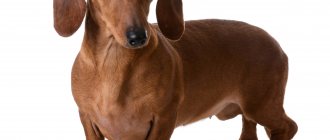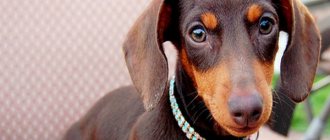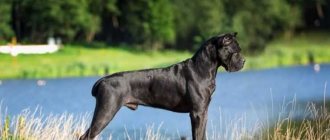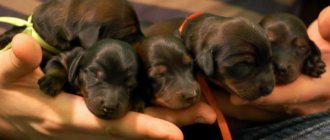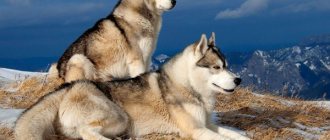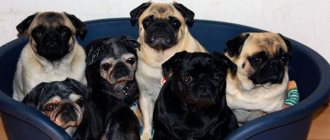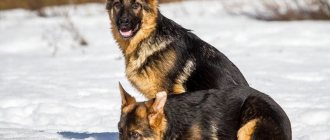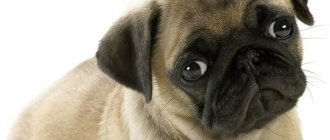Black dachshunds are perhaps one of the most recognizable dogs.
They often become heroes of feature and animated films, as well as characters in a wide variety of literary works.
And on the street you can see black dachshunds much more often than any other color.
Some people may find this color less interesting than, for example, bright red or harlequin.
But we must not forget that the black color of these dogs is considered classic and that it is one of the most beloved and popular.
Origin story and what it looks like in the photo
Black dachshunds are one of the oldest dog breeds in the world . Even in Ancient Egypt there were hunting dogs with short legs, an elongated body and a long saber-shaped tail.
They were distinguished from modern dachshunds by a slightly different shape of the head and muzzle, and also by the fact that Egyptian dogs had erect rather than drooping ears.
Real dachshunds were bred in the Middle Ages, on the territory of modern Germany . According to some sources, squat, fold-eared dachshund dogs have been found there since the 15th century.
But, if you believe official documents, then dachshunds as a breed appeared later: in the 18th century.
And they already had the same features as modern dogs, with the exception that the first dachshunds were distinguished by a slightly more massive structure and at the same time were longer-legged.
The black color of dachshunds has long been considered the most preferable color for working dogs..
In any case, in most paintings of the 18th and 19th centuries with images of hunters and their dogs, you can see black dachshunds, although along with them there were originally dogs of other colors.
Puppy cost
The popularity of dachshund puppies has a positive effect on the price of the animal. A healthy pet-class puppy without a brilliant pedigree will cost 20-25 thousand Russian rubles. A breeding class for breeding purebred offspring will cost 40 thousand. A show class with an excellent pedigree will cost 60-80 thousand rubles.
The price of a dog intended for exhibitions is individual and depends on the qualities of the parents and the individual qualities of the puppy. Sometimes such pets cost even more than 80 thousand.
But if participation in exhibitions is not required, you can buy a family friend inexpensively. The popularity of such pets also has negative consequences. Cheap mixed-breed (not purebred) puppies are sold at bird markets. It is difficult for a baby to see all the characteristics required by the standard. Unscrupulous sellers often pass off such dogs as purebreds.
The best choice for purchasing a dog is a trusted kennel. There, the pet owner will be given a vaccination passport and guaranteed 100% purebred.
Marriage or breed?
The black and tan color is specified in the breed standard and is considered one of the most preferred. However, if the tan is very blackened and almost or completely merges with the main background, then this is considered a flaw.
If red hairs are completely absent, then such a dog is recognized as true black and is rejected from breeding..
Expert opinion
Kozhevin Semyon Kirillovich
Expert dog handler.
“The black dachshund looks graceful and elegant. The bright red tan contrasts nicely with the main jet-black background of the coat and gives the dog a less severe appearance. However, in some dachshunds the tan may be too large, extending over the forehead and rising above the elbows and hocks, making the dog look atypical for its breed. In addition, these dogs also have very darkened tan, which is why the dachshund can look pure black.”
Origin story: how do albinos appear?
Before the official recognition of the breed, breeders bred dogs of any color, as they were primarily interested in the working qualities of dachshunds.
White, dark-spotted dogs similar to dachshunds are depicted in ancient paintings and frescoes, indicating that these colors were quite popular in the past..
However, after the standard was approved, white dachshunds were excluded from breeding, but despite this, such puppies continue to appear from time to time.
What causes the appearance of white color in these dogs?
There may be several reasons for this:
- Lightened to white cream.
- Leucism, or, in other words, true white color.
- Extreme degree of spotting. These dogs have individual colored hairs or small pigment spots on the skin.
- Albinism. In this case, the dog completely lacks pigmentation due to the fact that a genetic failure prevents the synthesis of pigments.
The birth of albino puppies is often caused by the mating of two marble-colored dogs.
Advantages and disadvantages
pros:
- Very smart and quick-witted dogs.
- Sweet and funny.
- Movable and energetic.
- They love children and willingly play with them.
- They can protect the house well.
- The black dachshund is an excellent hunting assistant.
- When properly maintained, they rarely get sick and live long enough.
- They look graceful and elegant.
Minuses:
- They may be prone to breed-related ailments, including diseases and injuries of the spine, as well as diseases of the eyes and ears.
- If they are not fed properly, they will quickly become obese.
- They often get into fights with other people's dogs, even if the enemy is much larger and stronger.
- They dig up soil in flower beds and beds, and in apartment conditions they like to turn over flower pots.
- If you allow children to tease your dachshund or pull its tail and ears, it can bite them quite hard.
Like most hunting dogs designed to work independently, black dachshunds are distinguished by great conceit and, at times, excessive independence.
These dogs may refuse to follow their owner's orders, and in this case it can be difficult to redirect them.
History of the breed
The pedigree of elongated dogs goes back a long way. Even in the tablets of the ancient Egyptians there is a mention of the dachshund. The name of the breed appeared much later and translated from German means “badger dog.” The first short-legged creatures began to be bred in Germany.
At first it was culling hounds. The dogs were not suitable for running long distances and could not participate in driving the beast. But thanks to its amazingly sensitive sense of smell, the breed began to be used in another type of hunting - norn.
Here the combination of short legs with an elongated body came in handy. Rejected hounds easily penetrated the holes of badgers, foxes and other animals. The fishing turned out to be so successful that it became the reason for selection. Thus a new breed of slow-moving hounds appeared.
The first representatives of the species are short-haired individuals. After crossing with spaniels, the shaggy dachshund was born, which immediately gained popularity among hunters due to its gentle disposition.
Dimensions, weight and other distinctive features
The black dachshund can be one of three acceptable sizes:
- Standard. The weight of these dogs is about 9 kg.
- Miniature. Typically, they weigh from 4 to 5.5 kg.
- Rabbit. Weight is approximately 3.4-4 kg.
The size of dachshunds is determined not so much by height at the withers, but by chest girth.
At the same time, for standard dogs it should be more than 35 cm, for miniature dogs - 30-35 cm, and for rabbit dogs less than 30 cm.
The most characteristic features that make the appearance of a black dachshund well recognizable are::
- Low stature, combined with a very elongated body.
- Short but straight and strong legs.
- The head has the typical shape of a hunting dog with long, high-set ears hanging along the cheeks.
- Strong, quite powerful mouth.
- Black and shiny nose.
- Slightly slanted dark brown eyes of medium size with an intelligent and attentive expression.
- Medium length, not thin, but not particularly thick, saber-shaped tail.
The coat of these dogs has a rich jet-black hue, with the bright, reddish-red tan markings provided for by the standard contrasting with it..
Weakened, blackened or too large tan extending to the dog's eyebrows and forehead is considered a serious fault.
White markings are acceptable if they are on the chest and are small in size.
Main characteristics
| Breed parameters | |
| Country of origin: | Germany |
| Weight of the breed: | 2-9 kg (depending on type) |
| Height at withers: | 15-25 cm (depending on type) |
| Temperament: | active |
| Wool: | long |
| Role in human life: | companion, hunting |
Despite his slightly stubborn nature, the Dachshund is very affectionate with his family. With proper upbringing, a pet will become a wonderful friend for a grown-up child. Representatives of this short-legged breed know how to have fun, and it is difficult to get bored with them. If systematic training is started from an early age, the dog can master many commands. A high level of intelligence and intelligence helps the pet in this.
Types by coat type
In addition to size varieties, dachshunds are also divided into species based on their coat type.:
- Smooth-haired. The coat is close to the body, smooth, short and shiny. It is not rough to the touch, but rather soft.
- Long-haired. Long hair is found only on the body, paws and ears, as well as on the tail. On the head and muzzle it is short and close-fitting.
- Wirehaired. The fur is quite hard and wiry. On the head and face of the dog there is fine hair in the form of a mustache, beard and shaggy eyebrows, which makes these dachshunds look like short-legged terriers.
Parameters of the smooth-haired dachshund
The dog's body is elongated and squat, its legs are short and powerful, which is convenient for movement, the muscular system is well developed, the dog is nimble, agile and flexible, ready to crawl through even a narrow hole. The dachshund's head is elongated with an elongated muzzle, which is not pointed. Smooth jaws with 42 teeth have a strong grip. The eyes are clear, round and have a friendly look. The ears are of medium length, the tips reaching the cheekbone. The belly is tucked, and the body is graceful and each part of it flows smoothly into another, for example, the neck to the body. The limbs make up one third of the dog's height at the withers. The coat of the smooth-haired dachshund is very coarse and the hairs are densely packed. These parameters represent the general appearance and type of constitution of the smooth-haired dachshund.
Popular black color options
- Black and Tan . With this color, the dog has bright red tan markings on the face, in the form of dots above the eyebrows, on the neck, chest, paws and under the tail.
- Pure black . True black dachshunds are very rare. Most likely, a dog with this coloring only looks black due to the heavily darkened tan.
- Black and white . This color, considered non-standard, is rarely found in dachshunds. With it, there are white spots on a black background, larger in size than those allowed by the standard or located not on the chest, but, for example, on the head or paws.
- Black and tan with white . This color, also not officially recognized, is similar to the previous one, with the exception that in addition to white marks on a black background there is also a reddish tan.
NOTE!
It should be remembered that although a purebred dachshund may well be non-standard in color, true black, black and white or black and tan and white colors are not typical for purebred dogs.
Therefore, if a dog that looks like a dachshund has a black color complemented by large white spots or if it has no tan completely, then this is a reason to suspect that it is a mixed breed.
Varieties of white dachshund colors with photos
- Black and white . There are quite large black spots on a white background.
- Brown and white . The main background is white; there are brown spots of various sizes and shades on it.
- Red and white . Red spots of any intensity and brightness, scattered over the white main color of the coat.
- Tiger-white . Brindle spots on a basic white background.
- Double merle on a white background . Marble color, complemented by large white spots, occupying more than 50% of the total body area.
- Speckled . Small speckled spots are scattered on a white background. Their number can vary, to the point that the dog has only one, barely noticeable dark spot.
- Cream . Highly bleached cream looks like white, but usually has a subtle yellowish tint.
- True white . The color of the coat is pure white, the pigmentation of the nose, edging of the eyelids and lips is black or brown.
- Albino . A color completely devoid of pigmentation, in which even the pupils look reddish. The eye color is either pale blue or pinkish red.
The white-spotted color should not be confused with the marbled color: with the latter, the main background is not white, but a beige or grayish tint.
Life expectancy and health
On average, black dachshunds live 12-13 years .
Typically, they rarely get sick, but due to their highly elongated body shape, they can be prone to spinal diseases and injuries.
In addition, these dogs may have other diseases, such as:
- Epilepsy.
- Eye diseases.
- Inflammation of the ears.
- Obesity.
- Hernia.
Dachshund puppies may also have the so-called “swimmer’s syndrome” - chest deformation . In severe cases, puppies suffering from this pathology cannot rise to their paws or walk at all.
Fortunately, the risk of acquiring a baby with this disease is minimal: after all, “swimmer’s syndrome”, as a rule, is clearly visible already at the age of 1 month.
Colors of dachshund varieties
The permitted colors are relevant for all sizes of dachshunds - the RKF has approved a single breed standard for color.
The only difference in possible coat color is allowed for wire-haired dachshunds of any size: they are allowed boar color, which is a defect in representatives of the breed with a different type of coat.
It can only be noted that fans of the dwarf variety show increased interest in complex and unusual coat colors. This is understandable, because the main value of a mini-dachshund is its decorativeness, and not its performance characteristics.
Basic rules of care
Caring for the coat of a black dachshund depends on what type it is..
And, if for smooth-haired pets of this breed regular brushing of the coat is sufficient (twice a week, and during shedding - daily), then long-haired and wire-haired dogs will require special care.
IMPORTANT!
Long-haired dachshunds need a little haircut, and wire-haired ones need special trimming.
While learning how to cut a pet with long hair is easy on your own, trimming a wire-haired dachshund is not so easy and requires special skills.
Therefore, at least for the first time, it is better to entrust the groomer to tidy up the dog, rather than try to trim the dog yourself.
In addition to grooming, all dachshunds require daily eye, ear, and teeth care . If necessary, they are cleaned, and if the claws grow too long, they are trimmed using a special nail clipper, but not nail clippers or scissors.
Features of wool
The coat should be shiny. Its length is about 2 cm, the hairs lie tightly to the skin. It feels like silk, but not thin, but durable and strong. There should be no areas with bald spots on the body. Wool is an indicator of a dog's health. Dull indicates problems, like brittle and sparse.
Short hairs make grooming your dog easier. For hunting this is an undeniable advantage. This type of fur is noticeable in the house and difficult to remove using conventional methods. These dachshunds do not have an undercoat, but they rarely get cold due to their activity.
Heavy shedding occurs 2 times a year, as well as during puberty. In warm climates, wool shedding may occur once a year. Bitches also shed after giving birth, when they are nursing a litter. In smooth-haired dachshund puppies, the outer hair structure is practically no different from the adult version.
How to choose?
Currently, there are a lot of black dachshunds and, as a result, there are many advertisements for the sale of such puppies. The babies look so touching and adorable that it is very difficult to resist buying one of them.
And yet, I would like to warn potential owners against purchasing a future pet through an advertisement or on the poultry market.
Most of these puppies do not have documents about their origin . It is not even known whether their father and mother are purebred dachshunds, let alone whether they were rejected from breeding due to any shortcomings.
CAREFULLY!
You need to purchase a black dachshund through a kennel club or from a reliable kennel that has proven itself well.
Even if we are talking about buying just a pet, it is better to buy a pet-class pet, but with documents, than without any metrics at all.
When choosing a baby, you need to pay special attention to its exterior, including the intensity and contrast of the tan.
It is very important that the dachshund puppy is friendly and sociable in nature. In addition, the dachshund should look vigorous, healthy and cheerful, and its movements should be free and not constrained.
The black dachshund is one of the most beloved and recognizable dogs in the world . Despite the fact that this coat color is very common among representatives of this breed, black dachshunds do not look boring or monotonous at all.
Due to their unusual appearance, these dogs with a highly elongated body and short legs already seem funny and original.
And the black and tan color of dachshunds is a classic, which is highly valued by many judges at exhibitions, and therefore, it is often the dog with this coat color that becomes the champion of the breed.
Prohibited colors
Isabella is a lightened color. It is a variation of brown color. It is characterized by a lightened nose. Such dogs may have health problems, especially skin diseases and decreased immunity.
Isabella coloring is also common among Dobermans. Blue is considered to be a derivative of black. Also a prohibited color in the FCI system.
Important: For American dachshunds, blue and isabella colors are considered standard. These dogs are officially allowed for exhibitions and breeding.
Spotted dachshunds have a striking appearance, but are not standard. They are distinguished by a large amount of white fur and spots. They are predominantly red in color. Many long-haired individuals are of this color.
Important: Tan and other variations are not allowed on a blue or isabella background.
White dogs with red spots in this breed were first bred in the 70s, but they never received FCI recognition. There are individuals with large black or coffee markings.
Cream dachshunds look cute. Their color is in delicate shades, very light and sunny. Yellow ones have richer pigment and a different nature of pigment formation in the hair.
Smooth-haired dogs also have boar coloring. Its description coincides down to the smallest detail with the description of the colors of wire-haired dachshunds. They are allowed only in the RKF system.
The way to international exhibitions is closed to them. The color is dominated by gray of varying saturation. It should not be confused with blue. The nose of “boars” with smooth hair is black, as are the claws, and the eyes are only dark.
Double marbled - refers to spotted dogs, but such dogs have large areas of white color. Eyes can be different colors, which is called “heterochromia”.
The elegant color with white spots is successfully bred in the USA. In some cases, double marbling makes the dog almost completely white.
Albinos are avoided in any breed. Their fur, iris, and nose are devoid of pigment. On the street in clear weather, the eyes of albinos glow red. Such individuals are sick, and the mutation occurred at the genetic level. Albino dachshunds are not allowed to breed in any cynological organizations.
Solid black color is most often a sign of cross breeding. Sometimes a faint tan peeks through the fur, which is completely darkened, but this is a completely different color. A specialist and breeder will always distinguish a black dog from a tan one.
Photo and video review
We recommend taking a look at the photos of dachshunds presented in the gallery to truly appreciate the breed. A video from the life of playful creatures will not leave anyone indifferent.
Education and training
When owning short-legged dogs with long hair for hunting or as a pet, training a puppy is approached with the utmost responsibility. The future habits of the pet depend on the owner.
The dog’s behavior is formed from the first days, as soon as it gets into its new home.
- To prevent the puppy from spoiling household things, the pet is accustomed to its toys.
- The baby is not allowed to grab food uncontrollably while the owner puts it in the bowl.
- Dachshunds have hunting qualities in their blood; the puppies do not miss a single cat or dog on their way. Therefore, when raising such a pet, they develop restraint in it.
Expert opinion
Anna Abramenko
An avid dog lover. Experience in veterinary medicine since 2009.
Ask a Question
Dachshunds are very sociable animals; dogs often playfully jump on people. It is recommended to wean puppies from this habit.
Dachshunds begin training from infancy. Already at 4 months, puppies quickly learn commands. If the goal is to raise a non-hunting dog, it is enough to limit yourself to a small set of the most common exercises. Classes are structured taking into account the pet’s disposition.
Breed training methods:
| Name | Description |
| Mechanical | The command is reinforced by influence (slap, light blow of a twig, pulling on a leash) in case of an incorrect reaction. The important point here is not to “go too far” |
| Incentive | For each well-executed command, it is recommended to reward the dog with praise, affection or a tasty bonus. |
| Combined | Includes features of the first two methods |
| Imitative | The method is used in joint training of adult dogs and puppies |
In order for training to give an effective result, a number of basic rules are followed:
- training begins if the owner and puppy are in a good mood;
- during classes, at first, exclude all surrounding stimuli;
- commands are pronounced in a clear, calm voice so that the dachshund understands the meaning of what was said;
- to reinforce past lessons, they are repeated in new lessons, changing the sequence;
- If the puppy loses interest, training is stopped.
To attract the dachshund's attention to learning, education is carried out in a playful way. It is not advisable to use only the mechanical method for small dogs. Giving your puppy rewarding treats can be more effective.
